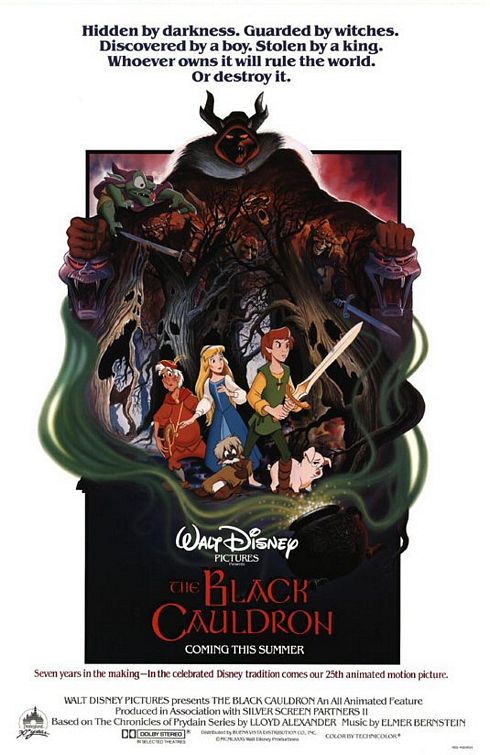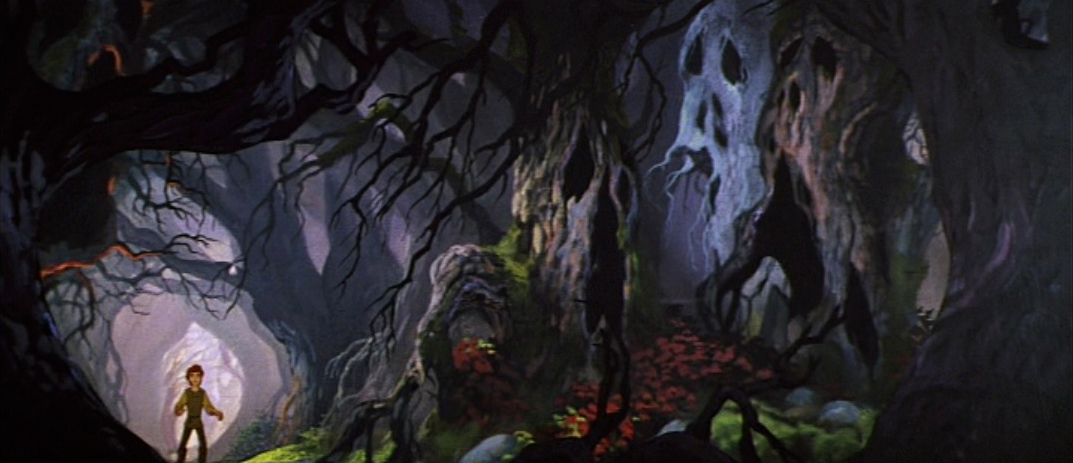Tim here . This month at the Film Experience, we're celebrating the year 1985 in movies, and in the chronicles of animation history, that can mean only one thing. I refer to the evergreen tale of how Walt Disney Pictures nearly extinguished itself during the hideously protracted, agonized production of the animated feature The Black Cauldron.
. This month at the Film Experience, we're celebrating the year 1985 in movies, and in the chronicles of animation history, that can mean only one thing. I refer to the evergreen tale of how Walt Disney Pictures nearly extinguished itself during the hideously protracted, agonized production of the animated feature The Black Cauldron.
This was near the end of almost two straight decades, following Walt Disney's death in 1966, during which time the company with his name on it couldn't put a single foot right. The days of Marvel, Star Wars, and billion-dollar cartoons weren't so much as a glimmer at this time; Disney barely existed as a film studio at all, but was internationally known almost exclusively for its theme parks. Still, live-action films trickled out every so often, and about once every four years, the animation studio would try its hand at a new cartoon. The most ambitious and expensive of these by far was an attempt at adapting the five books of Lloyd Alexander's 1960s series The Chronicles of Prydain into a high fantasy epic like the world of animation had never seen.

There were two main problems with this scheme...
The first was that The Chronicles of Prydain told a dark story full of evil, death, and fantasy violence that in no way resembled the soft-edged comedies that had become the studio's stock in trade since the dawn of the 1960s.
The second was that there was nobody minding the wheel by this point. The old guard of animators who had been leaders at the studio since the 1930s were retiring or dead, and the young animator who was clearly in the best position to take up the mantle of artistic leadership, Don Bluth, left in 1979 with several of the most talented Disney staffers, objecting to the clumsy corporate management that had no clue what to do with the Disney animated legacy. This meant that there was nobody to take firm control of The Black Cauldron.

The result was a scarring five-year experience for all involved, as disconnected teams of animators toiled on disconnected sequences without any clear sense of how their work was meant to tie into the rest of the film, and without any tangible reward for their labor. Infamously, the experience drove away several talented people from Disney, or animation altogether: Tim Burton was one of the most prominent causalities, and future Disney executive John Lasseter jumped ship to go work at Apple's newborn animation company, Pixar.
The aimless production cost a fortune: no budget has ever been officially reported, but the rumor that it cost somewhere in the $40 million range would make it by a tremendous margin the most expensive piece of animation in history. And this left Disney's executives vulnerable in the face of nervous shareholders, which is how in late 1984 the company was taken over by Walt Disney's nephew Roy Disney, along with Michael Eisner and Jeffrey Katzenberg from Paramount. The latter man was given the task of fixing the animation studio by himself, and his first task was to rip the guts out of The Black Cauldron and re-assemble it, removing a reported 12 minutes of completed animation, among other less dramatic steps. And this led to even more damage to the already tenuous morale in the animation department.

The film that ultimately crawled into theaters after all of this was irretrievably damaged. In its finished form, the plot of The Black Cauldron is messy wreck, shifting between episodes with little sense of how they fit together, and the characters are more suggestions of personalities than actual figures. Still, there's plenty to admire in the film's craftsmanship, with is certainly much richer and more detailed than anything the studio had released in the 26 years since Sleeping Beauty.
The film was the first (and, I believe, the last) Disney production to use a new method of copying animation drawings onto celluloid, resulting in softer, cleaner lines than the scratchy appearance of most Disney animation in the preceding decades. Coupled with a dramatic color palette of dark greens, purples, and reds, and the 70mm Technirama stock that the film was printed on – a costly format only used for animation once before, with Sleeping Beauty – there's no denying that The Black Cauldron is an achingly beautiful, exquisitely handsome film.
It's perhaps for that reason that the film has amassed a cult following for itself; that and the novelty of a grim, violent Disney fantasy, I suppose. At the very least, the film deserves better than the burial Disney has given it (at the time of this writing, it's one of only five Disney animated films never released to Blu-Ray), though it's value is certainly more than of an amazingly broken curio than an actual successful movie to watch on its own merits. Or as an object lesson in what happens when very expensive movies get made without anybody quite figuring out what in hell they're doing or why.

previously in our '85 look back
The Breakfast Club
Brazil
Madonna Mania
vote on the smackdown